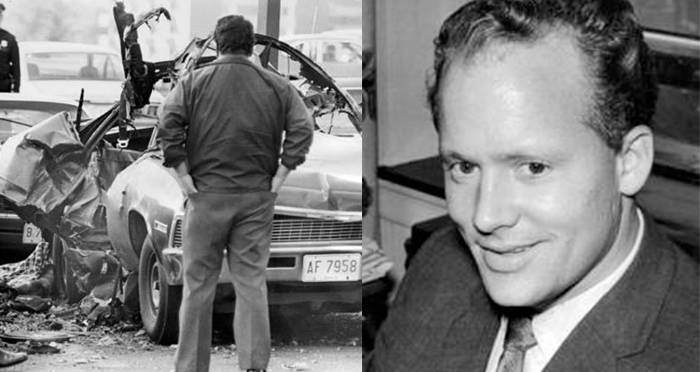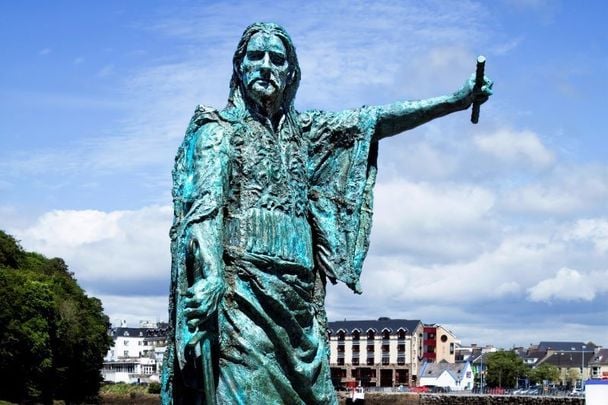

In a city choked by corruption and cowed by the Mafia’s iron grip, Danny Greene walked the streets of Cleveland like a man who couldn’t be touched. His defiance wasn’t whispered; it roared. With his signature charm, audacity, and a fearlessness that bordered on madness, Greene became the embodiment of Irish resilience in a criminal underworld dominated by Italians. But Greene wasn’t just another gangster—he was a disruptor, a man who dared to turn the Mafia’s own rules against them.
Danny Greene’s life is the stuff of legend, a Celtic tale rewritten in gunpowder and blood. This is the story of a man who rose from nothing, carved his name into Cleveland’s underworld, and left behind a legacy as explosive as the car bombs that defined his war.
👉 Discover the legacy of Dean O’Banion and his fight against the Chicago Outfit at Secret Ireland.
👉 Explore the untamed life of Vincent “Mad Dog” Coll at Secret Ireland.
👉 Learn about Jimmy Coonan and The Westies at Secret Ireland.
👉 Dive into the rivalry of Bugs Moran and Al Capone at Secret Ireland.
The Celtic Warrior’s Early Days
Daniel John Patrick Greene was born on November 14, 1933, in Cleveland, Ohio, to Irish-American parents. His early life was anything but fortunate. Orphaned at a young age, Greene spent his formative years in a Catholic orphanage. It was there, amidst the rigid discipline and isolation, that he developed the fierce independence and iron will that would define his later years.
As a young man, Greene worked on the docks and quickly became involved in union activities. His natural charisma and knack for leadership made him a rising star, but it also drew him into the darker world of corruption. By the 1960s, he was running the Cleveland International Longshoremen’s Association, and his methods were as brutal as they were effective. Greene was no stranger to violence, and his willingness to break bones—or worse—earned him both enemies and a reputation.
The Rise of the Celtic Club
Greene’s control over the docks gave him a taste of power, but he wanted more. After being ousted from the union under accusations of embezzlement, Greene formed his own organization—the Celtic Club. This group became a hub for his operations, which included loansharking, racketeering, and extortion.
But Greene wasn’t content to be a small-time operator. He saw himself as a modern-day Irish revolutionary, a Celtic warrior taking on the Mafia’s dominance in Cleveland. He made no secret of his ambitions, openly mocking the Italian mob and taunting its leaders. His defiance earned him both admiration and a death sentence.
War with the Mafia
The Cleveland Mafia, led by James Licavoli, viewed Greene as a dangerous wildcard. His refusal to fall in line and his public provocations made him a target, and in the early 1970s, the Mafia launched a campaign to eliminate him. Greene responded with his own war, and the streets of Cleveland soon became a battlefield.
The Car Bomb Era
Greene’s war with the Mafia was defined by explosions. Both sides used car bombs as their weapon of choice, turning Cleveland into the “Bomb Capital of America.” Greene narrowly survived several assassination attempts, including one where he emerged from the wreckage of a bombed car unscathed, earning him an almost mythical reputation.
His survival wasn’t just luck—it was strategy. Greene lived minimally, often staying in safe houses and avoiding predictable patterns. His fearlessness and ability to outmaneuver his enemies made him a legend, but it also made him a marked man.
👉 Learn about the fearless Vincent Coll and his war with the Mafia at Secret Ireland.
The Robin Hood of Cleveland
Greene cultivated an image as a man of the people. He embraced his Irish heritage, often quoting Irish proverbs and likening his struggle to that of Irish revolutionaries fighting against British rule. He surrounded himself with symbols of Irish pride, from Celtic crosses to green jackets, earning him the nickname “The Irishman.”
To some, Greene was a hero—a man standing up to the Mafia’s tyranny. He handed out money to struggling families, supported local charities, and presented himself as a protector of the working class. But to others, he was a ruthless gangster whose tactics were no different from those he fought against.
The Fall of Danny Greene
Despite his cunning and resilience, Greene’s war couldn’t last forever. On October 6, 1977, his enemies finally caught up with him. As Greene waited outside his dentist’s office in Lyndhurst, Ohio, a car bomb detonated, killing him instantly. The explosion marked the end of one of the most volatile chapters in Cleveland’s underworld.
The Aftermath: A Legacy of Defiance
Danny Greene’s death didn’t end the violence in Cleveland, but it did weaken the Mafia’s grip on the city. The FBI used the chaos to dismantle the Cleveland Mafia, leading to the eventual collapse of its operations. Greene’s war had exposed the Mafia’s vulnerabilities, and his defiance inspired a new era of resistance against organized crime.
What Danny Greene Taught the Underworld
Danny Greene’s life is a cautionary tale about power, loyalty, and the cost of defiance. He was a man who refused to bow, even when the odds were stacked against him. His story is one of ambition, audacity, and an unrelenting belief in his own invincibility.
But Greene’s legacy isn’t just about his war with the Mafia. It’s about the spirit of a man who saw himself as more than a criminal—a warrior fighting for his place in a world dominated by enemies. His life, like those of other Irish-American gangsters, reflects the resilience and complexity of the Irish immigrant experience.
👉 Explore the lives of other Irish-American gangsters at Secret Ireland.
👉 Discover the rivalry between Bugs Moran and Al Capone at Secret Ireland.
Final Thoughts: The Irish Spirit in a Ruthless World
Danny Greene wasn’t just a gangster—he was a force of nature. His defiance, resilience, and unapologetic embrace of his Irish heritage made him a figure who stood out in a world of shadows. Whether you see him as a hero or a villain, there’s no denying the impact he had on Cleveland and the legacy he left behind.
In the annals of Irish-American history, Greene’s story stands as a testament to the unbreakable spirit of the Irish—a spirit that refuses to kneel, no matter the odds.
👉 Dive deeper into the stories of Irish-American gangsters at Secret Ireland.





1 thought on “Danny Greene: The Celtic Warrior Who Declared War on the Mafia”
Comments are closed.